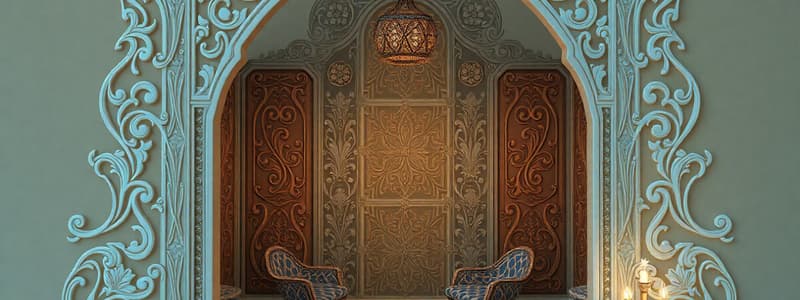Podcast
Questions and Answers
What component in A-Frame is used to define a viewer's perspective?
What component in A-Frame is used to define a viewer's perspective?
- Cursor
- Image
- Primitives
- Camera (correct)
Which primitive in A-Frame creates a 3D cube or rectangular box?
Which primitive in A-Frame creates a 3D cube or rectangular box?
- Box (correct)
- Sphere
- Plane
- Cylinder
What transformation does the scale component perform in A-Frame?
What transformation does the scale component perform in A-Frame?
- Changing the color of an entity
- Altering the size of an entity based on X, Y, and Z axes (correct)
- Moving an entity from one point to another
- Rotating an entity around a specified point
What does the relative scale transformation do in A-Frame?
What does the relative scale transformation do in A-Frame?
What does the rotation transformation in A-Frame affect?
What does the rotation transformation in A-Frame affect?
What is the purpose of a cursor in an A-Frame virtual environment?
What is the purpose of a cursor in an A-Frame virtual environment?
In A-Frame, what is the effect of scaling an entity by a factor of 0.5 along the X axis?
In A-Frame, what is the effect of scaling an entity by a factor of 0.5 along the X axis?
Which of the following options is NOT a primitive available in A-Frame?
Which of the following options is NOT a primitive available in A-Frame?
Flashcards
Brackets
Brackets
A web-based code editor for creating and editing A-Frame files.
A-Frame
A-Frame
An open-source framework for building virtual reality experiences using HTML, CSS, and JavaScript.
A-Frame Primitives
A-Frame Primitives
Basic building blocks in A-Frame that represent 3D shapes or elements. Examples include box, camera, cursor, image, and circle.
Transformation in A-Frame
Transformation in A-Frame
Signup and view all the flashcards
Scale Component (A-Frame)
Scale Component (A-Frame)
Signup and view all the flashcards
Reflection (A-Frame)
Reflection (A-Frame)
Signup and view all the flashcards
Rotation Component (A-Frame)
Rotation Component (A-Frame)
Signup and view all the flashcards
Position Component (A-Frame)
Position Component (A-Frame)
Signup and view all the flashcards
Study Notes
Designing and Building Virtual Environments - Chapter Four
- This chapter focuses on object and scene modeling using A-frame.
A-Frame Code Editors
- Brackets: A modern, open-source text editor specifically designed for web development, supporting HTML, CSS, and JavaScript.
- Glitch: A collaborative, in-browser coding platform ideal for quickly building and deploying web applications, useful for prototyping and real-time collaboration.
Using Brackets
- Download Brackets from https://brackets.io/.
- Open Brackets on your computer.
- Create a new file by going to File > New.
- Save the file as HTML by navigating to File > Save As...
- Name the file with the .html extension (e.g., index.html).
- Choose a location on your computer to save the file and click Save.
A-Frame using Brackets
- This section details how to use A-Frame with Brackets to model objects and create scenes.
- Images illustrate steps within a file editor to generate different types of objects.
A-Frame
- A-Frame is a popular framework for creating VR experiences.
- It is built on top of HTML and the DOM (Document Object Model).
- A-Frame utilizes 'polyfills' for extending HTML functions to add VR-specific tags (
, , ), directly within HTML. - A-Frame integrates seamlessly with numerous web development libraries (React, Vue.js, Angular, D3.js, and jQuery).
- This compatibility allows combining VR capabilities with interactive user interfaces, data visualizations, and dynamic web content.
A-Frame with Code Example
- A code example displays a light blue box positioned slightly left, raised, and rotated 45 degrees around the vertical axis.
- The box becomes a VR element in an A-Frame-compatible browser.
- The example uses HTML attributes for defining the box's position, rotation, and color.
A-Frame Primitives
- A-Frame offers built-in primitives for creating 3D objects like boxes, spheres, cylinders, and planes.
- These primitives are fundamental components for building complex 3D models within the A-Frame environment.
- Users can add
, and elements to add images and define the viewer's perspective. - Developers can add cursors to interact with VR objects.
Customizing A-Frame Primitives
- Developers have the flexibility to create and register their own custom primitives in A-Frame.
- A custom primitive is registered using
AFRAME.registerPrimitive(name, definition). - The primitive
namemust contain a dash (e.g., 'a-foo').
A-Frame Primitives - Example
- Visual representations of various A-Frame primitives such as
, , , , and are shown in the context of an A-Frame scene.
A-Frame Primitives - Extended Example
- A more comprehensive code example using A-Frame primitives showcases creating different elements like boxes, spheres, and cylinders with specifications.
Meshes and 360° Content
- Meshes represent 3D shapes in A-Frame.
- 360-degree content, such as photos, videos, and backgrounds, surrounds the user.
- Example: Using
<a-sky src="path/to/image.jpg">creates a 360-degree background.
A-Frame Camera
- A-Frame automatically includes a default camera, allowing viewers to interact with the scene without explicitly adding one.
Transformations in A-Frame
- Transformations in A-Frame include scaling, rotation, and positioning.
- Scaling: Affects the size; factors for the X, Y, and Z axes can be positive or negative (signifies reflection).
- Rotation: Defines the orientation of an entity; uses pitch (x), yaw (y), and roll (z).
- Position: Locates an entity in 3D space; represented by x, y, and z coordinates.
- The order of operations for transformation is Scale, Rotation, Position.
- Transformations are relative to their local coordinate system rather than the global coordinate system.
- Transformations nested entities are multiplicative.
Resource
- The resource for this A-frame framework is: https://aframe.io/
Studying That Suits You
Use AI to generate personalized quizzes and flashcards to suit your learning preferences.



